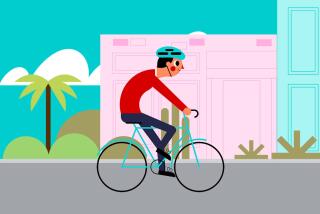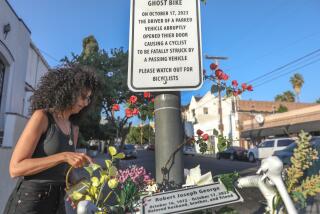Biking Business Tries for Brake on Suits : Safety: Cyclists must confirm knowledge of equipment, rules of road. Caution stems from New Jersey case in which man sued manufacturer for failing to warn him not to ride at night without a light. He won $7 million.
AMBRIDGE, Pa. — Salesman Gary Bywaters is no lawyer, but he has to act like one when it’s time to close the deal.
Bywaters doesn’t sell houses or guns; he sells bicycles.
For almost every bike sold by Bywaters and his staff at the Ambridge Bike and Sports Center near Pittsburgh, the sale is consummated only when the customer signs a formal checklist--an intelligence test of sorts.
Bywaters’ list includes items about the helmet, brakes and owners’ manual. The last sentence says, “By initialing each item on the above checklist, I have indicated my complete understanding of these points, and I acknowledge my responsibilities regarding the contents.”
If it sounds like a court document, that’s because a witness might someday read it in court.
Cyclists from Vermont to California are being asked to confirm in black and white their basic knowledge of equipment and safety features.
Makers and sellers of bicycles are taking such steps because they worry about being sued. Heightening their fears is a New Jersey jury’s recent $7-million award to a cyclist who was traveling at 40 m.p.h. when he collided with a moving Jeep one night five years ago.
England’s Derby Cycle Corp., the world’s largest bike maker, settled on appeal to reduce the payment to Collin Johnson to $3.25 million.
The fact that the Nishiki Royale was equipped with reflectors led Johnson--an honor student from West Orange, N.J.--to believe he would be visible at night, according to his attorney, Ken Berkowitz. He said Johnson, now 22 and partially paralyzed, should have been advised that he needed to a install a light.
“That case has made everybody more sensitive,” said Marc Sani, editor of the Bicycle Retailer and Industry News trade magazine.
The spread of checklists indicates the depth of concern in the bike business. Sutherland’s Bicycle Shop Aids Inc., a Berkeley, Calif., supplier to bicycle stores, shipped 400,000 checklists last year and expects to ship 600,000 this year.
One retailers’ group, the National Bicycle Dealers Assn., estimated that one in five retailers uses some type of questionnaire. Almost no one used the forms five years ago.
The Bike Gallery stores in Portland, Ore., use checklists. In Burlington, Vt., the Ski Rack’s attorneys approved an eight-question list that includes queries about handlebar alignment, helmets and tire pressure.
Ski Rack co-owner Zandy Wheeler said even though customers might roll their eyes during a lecture on bikes, it’s worth the investment of time.
“The rules of the road apply to a bike as well as a car, and that’s often news to people. They say, ‘You mean I can’t ride on the sidewalk?’ ” Wheeler said.
A man who bought two mountain bikes recently at Snitger’s Bicycle Store in Beaver, Pa., found the forms he signed to be “quite humorous.”
“It seemed so asinine. I’ve read things in the paper about the kinds of stuff people are suing for today--like riding a bike at night without lights. Common sense tells you that you have to do that. You wouldn’t drive your car at night without your lights on,” said Victor Banko of Center Township.
Bywaters said one or two buyers have refused to sign the voluntary forms in the year his store has offered them.
“We have always gone over the bike from top to bottom with the customer. This just formalizes the process,” Bywaters said.
Major bike producers--Cannondale, Giant, Trek and Specialized--recommend that retailers use the forms to explain bikes to customers. Specialized adds a checklist to manuals.
“It’s an informational thing,” Specialized spokesman Chris Murphy said from San Francisco. “Maybe someone hasn’t bought a bike for 30 years. A lot has changed since then.”
Bike shops balked at the forms in the early 1990s, fearing they would scare away customers or cut into sales time. Giant Bicycle Executive Vice President Nick Andrade said many dealers came around when their suggestions were considered and forms were shortened. Bike dealers say it takes up to 10 minutes to walk a customer through today’s checklists.
Even with the advent of forms, the attorney in the New Jersey accident case says the bicycle industry hasn’t gone far enough to ensure that bikes are safe.
“It seems shortsighted,” Ken Berkowitz said about the checklists. “Your chances of finding a warning in a manual are about like finding a needle in a haystack.”
Bicycle IQ Test
Items from a standard checklist presented by retailers to bicycle buyers:
* I have received the owner’s manual and agreed to read it, especially the safety warnings, before using the bicycle. I understand that all riders (adults and children) should wear a bicycle helmet whenever riding the bicycle.
* I understand that this bicycle is subject to all laws of the road, and that many states and localities have additional laws which specifically apply to bicycles.
* I have been advised of the proper size bicycle for me, but the final selection of this bicycle has been my own decision.
* I understand that regular maintenance is required to keep this bicycle operating properly and that failure to maintain may void the manufacturers’ warranty and may make the bicycle unsafe.
Source: Associated Press
More to Read
Inside the business of entertainment
The Wide Shot brings you news, analysis and insights on everything from streaming wars to production — and what it all means for the future.
You may occasionally receive promotional content from the Los Angeles Times.










